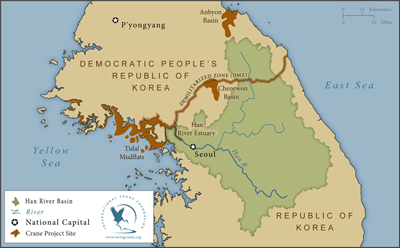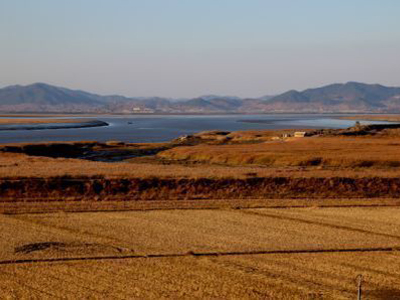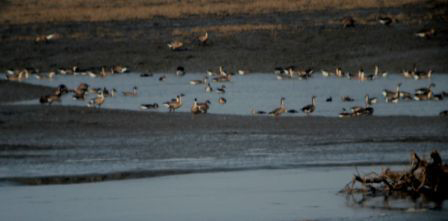Dr. George Archibald, ICF Co-founder & Senior Conservationist
The following are notes from my October 27-November 8, 2012 visit to North Korea. I was the guest of North Korea’s foremost ornithologist, Dr. Park U Il of the State Academy of Sciences (SAOS), with whom ICF has been working since my first visit in 2008. From our base at the Pyongyang Hotel, we traveled to three important sites for Red-crowned Cranes. Dr. Pak and I were accompanied by his colleagues, Dr. Sin Nam Hui (a great lady whose command of English surpasses mine), Dr. Ri Hak Chol, and Mr. Kim Kyomg Min, and our excellent driver, Mr. Lee Kyong Chol.
Learn more about ICF’s work in the Han River basin.
The Wintering Grounds of Red-crowned Cranes in Kangryong District
 Kangryong District borders the West (Yellow) Sea on an extension of North Korea that protrudes west beyond the northwest corner of South Korea. These western waters separating the neighboring nations are part of the DMZ. At high tide, the ocean meets the base of hills and dikes. At low tide wide expanses of mudflats are exposed. In 1987, Dr. Pak documented about 40 Red-crowned Cranes wintering along the coast of Kangryong District. When the mudflats were exposed, the cranes fed on small aquatic animals they pulled from the mud. When the tides were high, the cranes moved inland to drink fresh water and perhaps to feed on waste grain in rice paddies. The human population was low and the cranes thrived. Unfortunately, by the 1990s the crane numbers declined to about 10, and in recent years to half that number. Concomitant with this decline, massive reclamation of crane breeding habitat in northeast China was underway, and the human population in Kangryong District increased. In the 1990s, widespread food shortages in North Korea, forced tens of thousands of humans into western mudflats to find food where several hundred Red-crowned Cranes formerly wintered. As their numbers declined in North Korea, the crane population increased along the DMZ. Dr. Pak is confident that the local people did not kill the cranes but that disturbance was responsible for their decline. Red-crowned Cranes were officially protected as Natural Monuments in 1975, a designation that the individuals birds are sheltered, but not necessarily their habitat.
Kangryong District borders the West (Yellow) Sea on an extension of North Korea that protrudes west beyond the northwest corner of South Korea. These western waters separating the neighboring nations are part of the DMZ. At high tide, the ocean meets the base of hills and dikes. At low tide wide expanses of mudflats are exposed. In 1987, Dr. Pak documented about 40 Red-crowned Cranes wintering along the coast of Kangryong District. When the mudflats were exposed, the cranes fed on small aquatic animals they pulled from the mud. When the tides were high, the cranes moved inland to drink fresh water and perhaps to feed on waste grain in rice paddies. The human population was low and the cranes thrived. Unfortunately, by the 1990s the crane numbers declined to about 10, and in recent years to half that number. Concomitant with this decline, massive reclamation of crane breeding habitat in northeast China was underway, and the human population in Kangryong District increased. In the 1990s, widespread food shortages in North Korea, forced tens of thousands of humans into western mudflats to find food where several hundred Red-crowned Cranes formerly wintered. As their numbers declined in North Korea, the crane population increased along the DMZ. Dr. Pak is confident that the local people did not kill the cranes but that disturbance was responsible for their decline. Red-crowned Cranes were officially protected as Natural Monuments in 1975, a designation that the individuals birds are sheltered, but not necessarily their habitat.
Two villages, Songhyon and Tongpo, that lie at the base of the hills near the mudflats still used by cranes, are separated by a valley that extends inland for several kilometers. A massive dike between the hills was constructed to block both tidal waters that once bathed former mudflats and a fresh water stream that flowed into the Yellow Sea. The result was a huge fresh water reservoir for human use. The dike continued east beyond Tongpo and former mudflats were converted to a salt farm and agricultural fields. Salty soils reduce crop yield. Consequently, the standard of living of the humans in the coastal villages appear to be less than those more inland where soils are sweet and more productive. But unlike the inland farmers, the coastal villages benefit from the mudflats. At low tide they find aquatic animals (crabs, clams, seaworms) in the muddy soils.
Kangryong District is the only area in North Korea where Red-crowned Cranes continue to spend the entire winter. During our visit, a local man informed Dr. Pak that the cranes arrived in early November and departed in late March. Throughout the winter they move around over a wide area and are only observed at any one area every few days The mudflats are not only important to cranes in winter, each autumn and spring they undoubtedly provide critical habitat for thousands of shorebirds that migrate between breeding areas in northern latitudes to wintering sites in the southern hemisphere as far south as Australia. And in summer the coastal mudflats provide feeding areas for endangered Black-faced Spoonbills that number less than 2000 and that breed on islands near the Korean peninsula and in a few coastal areas of China and Russia. Consequently, Dr. Pak and his colleagues hope to embark on a projected titled, “Protecting threatened birds and their habitats by helping local people in Kangryong County”. The research will encompass Red-crowned cranes in winter, shorebirds in spring and autumn, and the endangered Black-faced Spoobills in summer. This project is internationally significant considering the rapid rate at which coastal wetlands are being reclaimed in China and South Korea and the threatened status of all the aforementioned birds.
 The Resting Area for Cranes on the Fabulous Estuary of the Chingchon River in Mundok District
The Resting Area for Cranes on the Fabulous Estuary of the Chingchon River in Mundok District
We had the great pleasure of visiting the estuary of the Chongchon River in Mundok County on the west coast (right). The intact portion of the estuary is bordered by high dikes behind which vast expanses of rice paddies dotted with villages spread to distant hills to the north and south. Dense stands of Phragmites dominates the upper tidal zones between the dikes and the river channel. The river eventually divides to create Yudo Island that almost disappears at high tide but is populated by short vegetation at the upper tidal zone. In South Korea on the estuaries of the Han and Imjin rivers, tubers of sedges of the upper tidal zone are major food items for White-naped Cranes and Swan Geese.
In mid-afternoon, we arrived at a vantage point on a hill within Sohori Village from which we could view most of the estuary. The tide was low and on the mudflats west of the island, to our amazement stood an enormous flock of Swan Geese, numbering perhaps in double digits of thousands, matched on the north side of Yudo by a massive gathering of unidentifiable dabbling ducks. Curlews (species?) and Common Shelducks, and unidentified shorebirds dotted Yudo. But sadly, cranes were absent. A Mr. U Jae Su , a former secondary school teacher employed by SAOS to monitor bird use of the Estuary, told us that several thousand Hooded Cranes should arrive during the first week of November. Dr. Pak in the spring of 1987 reported about 3000 Hooded, 70 Red-crowned and 400 White-naped Cranes in the basin. All cranes roosted at night on Yudo, and the Red-crowned and White-naped fed there throughout the day. However the Hooded Cranes fed in the nearby rice paddies. But they only remained a few days in spring, and seldom stopped at all in autumn. Fortunately, the estuary as been protected as Mundok Migratory Bird Reserve.
 The Swan Goose is of special interest to me. It is the largest wild goose in Asia, and the ancestor of the domestic Chinese Goose (the one with the knob at the base of its beak). They formerly nested on the riparian lowlands of the Amur River at what is now Muraviovka Park, a site I visit annually to help Dr. Sergei Smirenski and his staff. But the geese were eliminated by spring hunting. We dream of a reintroduction. In June of this year, I visited eastern Mongolia and had the pleasure of seeing two broods of newly-hatched goslings with the parents on the edge of a small lake. In South Korea I have seen several small flocks, but at China’s Poyang and Don Ting Lakes, I have experienced tens of thousands. Likely the geese on Yudo Island primarily migrate across the Yellow Sea to winter in China. Counting the geese was impossible because of the numbers and distance. So using my camera attached to my telescope, I photographed the entire flock seven times over three days (left). Dr. Pak and his colleagues now have the arduous task of splicing together 50 some photos per count and then counting!
The Swan Goose is of special interest to me. It is the largest wild goose in Asia, and the ancestor of the domestic Chinese Goose (the one with the knob at the base of its beak). They formerly nested on the riparian lowlands of the Amur River at what is now Muraviovka Park, a site I visit annually to help Dr. Sergei Smirenski and his staff. But the geese were eliminated by spring hunting. We dream of a reintroduction. In June of this year, I visited eastern Mongolia and had the pleasure of seeing two broods of newly-hatched goslings with the parents on the edge of a small lake. In South Korea I have seen several small flocks, but at China’s Poyang and Don Ting Lakes, I have experienced tens of thousands. Likely the geese on Yudo Island primarily migrate across the Yellow Sea to winter in China. Counting the geese was impossible because of the numbers and distance. So using my camera attached to my telescope, I photographed the entire flock seven times over three days (left). Dr. Pak and his colleagues now have the arduous task of splicing together 50 some photos per count and then counting!
The Anbyon Plain – former wintering area of 240-250 Red-crowned Cranes
While cranes in former times were scattered in winter over wide regions of mudflats along the west coast, the Anbyon Plain was the only wintering area near the east coast. The east coast is also a major migration route of Red-crowned Cranes travelling from breeding grounds in northeast China and southeast Russia to winter on the Korean DMZ. Because these lowlands of the DMZ are targeted to become “Reunification Cites” if history blesses the divided peninsula with such an eventuality, since 2008 we have joined forces with Dr. Pak and leaders at the Pisan Cooperative Farm (PCF) on the Anbyon Plain to recreate an excellent wintering area for the cranes. The first step was to help the farmers increase production with the hope that gleanings would once again be there for cranes.
Until 1990, North Korea had excellent relations with the USSR and as such received cheap but excellent fertilizer from their northern neighbors. That all changed in 1990. The reborn and capitalistic Russia demanded payment in cash for goods received. Unable to afford the life-giving fertilizers, North Korean farmers worked soils that were soon depleted of nutrients. In addition, several floods in the mid 1990s destroyed crops. Especially in 1997, widespread starvation swept across North Korea with tragic consequences for humans and wildlife.
Soil enrichment was a top priority for Mrs. Kim Yun Sim , the manager of the 1500-person PCF. From consultations with organic farming specialists in China, and following a comprehensive study of the literature on the practice, Dr. Pak wrote for North Korean farmers, a manual for organic farming. Test plots were developed at PCF and the results were most encouraging as crop production increased and nutrients and biodiversity in the soil were augmented. In 2005, the leaders of North Korea made an announcement that farmers should pursue organic farming for sustainable and productive agriculture. In 2010, PCF was selected as the nation’s top demonstration site. With government funding a factory was built at PCF to extract and concentrate nutrients from organic compounds. A 200 seat classroom theatre was provided in which lectures are given to visitors. Mrs. Kim was delighted to report that thus far in 2012, 40,000 people have visited PCF to learn.
But what about the cranes? Through the kindness of our colleagues in China, a pair of captive Red-crowned Cranes was provided to help attract the wild cranes to land on and near 126 acres of rice paddies within PCF near the Namdae River, dedicated as a crane reserve. In the center of the area, the captive cranes are kept in a fenced paddy. Other paddies are flooded with water and mudfish, a favorite food of the cranes, are abundant. Grains are scattered on the walkways that border the paddies. And farmers are advised to avoid walking in the vicinity of the reserve. To our delight the first groups of cranes landed in 2009. They stayed for several days and then continued on to the DMZ (traditions are hard to break even in the crane world). Cranes circled the reserve in 2010 but none landed. However, in 2012 more than 50 cranes landed and five remained for three weeks. The cranes are becoming familiar again with the Anbyon Plain, and Mrs. Kim and her colleagues are thrilled. After the migration period ends in mid-November, the captive cranes are moved back to a compound in Pisan Village where they serve as important ambassador of their kind both to the villagers and to the new influx of visitors from many places in North Korea.
A little seed money from ICF helped this happen. Thanks so much to those of you who have supported our work in North Korea, especially Hall Healy who has been my close colleague for almost a decade in growing this program. I also wish to thank Professor Chong Jung-Ryol of the Korean University in Japan and Noritake Ichida formerly with BirdLife International, for introducing ICF to the Anbyon Project, and a special thanks to Dr. Hiroyoshi Higuchi of Tokyo University, for unveiling our understanding of crane distribution in North Korea through his pioneering studies of crane migration using satellite telemetry.
